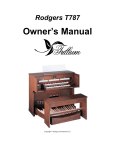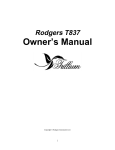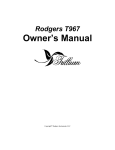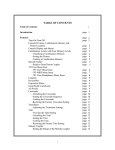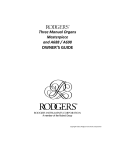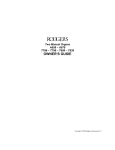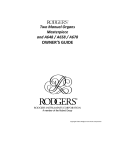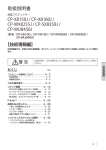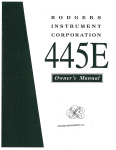Download Rodgers Instruments 795 Owner`s manual
Transcript
Rodgers 790C Owner’s Manual Copyright Rodgers Instruments LLC i SAFETY INSTRUCTIONS INSTRUCTIONS PERTAINING TO A RISK OF FIRE, ELECTRIC SHOCK OR INJURY TO PERSONS IMPORTANT SAFETY INSTRUCTIONS WARNING: WHEN USING THIS INSTRUMENT, ALWAYS FOLLOW BASIC SAFETY PRECAUTIONS, INCLUDING THE FOLLOWING: 1. Read all the instructions before using, adjusting or repairing this instrument. 10. Unplug the power cord of the instrument from the power source when left unattended for a long period of time. 2. To reduce the risk of injury, supervise children closely when they are around the instrument. 11. Do not walk on or place objects on top of the power cord. 3. Use this instrument only in the manner recommended by Rodgers Instruments LLC. 12. Do not pull the cord to unplug. Hold the plug when unplugging from the power source. 4 Do not use this instrument near water i.e. near a swimming pool or a damp/wet room. 13. 5. Use of this instrument, either alone or in combination with an amplifier and headphones or speakers, may be capable of producing sound levels that could cause permanent hearing loss. DO NOT operate for a long period of time at a high volume level or at a level that is uncomfortable. If you experience any hearing loss or ringing in the ears, you should consult an audiologist. When setting up with other instruments or peripherals, follow the procedures in accordance with Rodgers’ owner’s manual. 14. Take care that objects do not fall or liquids spill into the instrument. 15. Service the instrument with qualified service personnel when: a. The power cord or plug has been damaged. Locate the instrument so its position does not interfere with its proper ventilation. b. Objects have fallen or liquid has spilled into the instrument. 6. Locate the instrument away from heat sources such as radiators, heat registers or other products that radiate heat directly onto the instrument. c. The instrument has been exposed to rain or other weather damage. 7. Protect the instrument from dust as much as possible. d. The instrument does not appear to operate normally or exhibits a marked change in performance. 8. Connect the instrument to a power source only of the type described in the operating instructions or as marked on the instrument. e. The instrument has been dropped or the enclosure has been damaged. 9. Do NOT attempt to defeat the grounding connection of the three-prong attachment plug. This is a safety feature. If you are unable to insert the plug into the outlet, contact an electrician to replace your obsolete outlet. Do NOT defeat the safety purpose of the plug. 16. Do not attempt to service the instrument beyond that described in the owner’s manual. Refer all other servicing to qualified technical service personnel. WARNING: THIS INSTRUMENT MUST BE EARTH GROUNDED. You must GROUND instruments equipped with a TYPE AC, 3 WIRE GROUNDED PLUG. SAVE THESE INSTRUCTIONS ii FCC NOTICE Radio and Television Interference Rodgers organs use and generate small amounts of radio-frequency (RF) energy. The instrument complies with the limits set for Class A computing devices. FCC Rules, Part 15, Subpart J define the limits for radio and television interference in a residential installation. Follow the installation and the use instruction in the manual, or the instrument could potentially cause interference with some radio or television reception. In the unlikely event this occurs, we encourage the user to try the following corrective measures: 9 Turn the instrument OFF to see if it is the actual source of the interference. 9 Disconnect the peripheral devices and their input/output cables one at a time. If the interference stops, it is caused by the peripheral device or its I/O cable. 9 Try coiling and uncoiling the instrument’s power cord in different ways. 9 Connect the instrument’s power cord to a power outlet on a different circuit. 9 Move the instrument further away from the radio or television receiver. 9 Turn the radio or television receiver until the interference stops. 9 Connect the radio or television receiver to a different power circuit. 9 Reorient or move the receiver antenna further away from the instrument. Consider installing a rooftop antenna with coaxial cable lead-in between the antenna and receiver. 9 Consult the nearest Rodgers dealer for more information if the above corrective measures don’t remove the interference. iii WARNING TO REDUCE THE RISK OF FIRE OR ELECTRIC SHOCK, DO NOT EXPOSE THIS APPLIANCE TO RAIN OR MOISTURE ATTENTION: RISQUE DE CHOC ELECTRIQUE NE PAS OUVRIR CAUTION: TO REDUCE THE RISK OF ELECTRICAL SHOCK: DO NOT REMOVE COVER OR BACK. NO USER-SERVICEABLE PARTS INSIDE. REFER SERVICING TO QUALIFIED SERVICE PERSONNEL. PATENTS G.B. 1312161 F.R.G. 22 02 658 CANADIAN 951550 The lightning flash with arrowhead symbol, within an equilateral triangle, is intended to alert the user to the presence of uninsulated dangerous voltage with the product's enclosure that may be of sufficient magnitude to constitute a risk of electrical shock to persons. The exclamation point within the equilateral triangle is intended to alert the user to the presence of important operating instructions in the literature accompanying the product. Notice to Users Information in this document is subject to change without notice. No part of this manual may be translated into any language, stored in a retrieval system, reproduced or transmitted in any form or by any means, electronic or mechanical, including photocopying and recording, for any purpose without the express written permission of Rodgers Instruments LLC. RODGERS INSTRUMENTS LLC 1300 N.E. 25th Avenue Hillsboro, Oregon 97124 (503) 648-4181 RODGERS IN CANADA 5480 Parkwood Way Richmond, B.C. V6V 2M4 (604) 270-6332 ©Copyright 1999. Rodgers Instruments LLC, a member of the Roland Group. All rights reserved. Printed in the United States of America. QuickMenu™, Rodgers®, Rodgers Classic Organs®, Digital Dynamic Wind™, Dimensional Sound Modeling®, Parallel Digital Imaging®, Voice Palette™, DVM™, PDI™, TrueChimes™, and Trillium™ are trademarks or registered trademarks of Rodgers Instruments LLC, Hillsboro, Oregon. RSS® is a registered trademark of the Roland Corporation. iv Contents SAFETY INSTRUCTIONS......................................................................................................... II FCC NOTICE..............................................................................................................................III Radio and Television Interference ...........................................................................................iii Contents..................................................................................................................................... v INTRODUCTION......................................................................................................................... 1 FEATURES.................................................................................................................................... 2 Turn On/Turn Off...................................................................................................................... 2 Console Division, Combination Memory and Piston Locations............................................... 2 Console Display and Menus...................................................................................................... 2 Combination Action with Four Memory Levels ....................................................................... 3 Setting the pistons ............................................................................................................... 4 790C User Menu Items ............................................................................................................. 5 790C MIDI Menu Items............................................................................................................ 5 790C Headphone User Menu .................................................................................................... 6 Couplers .................................................................................................................................... 6 Reversibles ................................................................................................................................ 7 Expression Shoes ...................................................................................................................... 7 Great/Pedal Unenclosed ............................................................................................................ 7 All Swells .................................................................................................................................. 7 Crescendo .................................................................................................................................. 7 Tutti ........................................................................................................................................... 8 Melody Coupler......................................................................................................................... 8 Setting Melody Coupler Range ........................................................................................... 8 Bass Coupler ............................................................................................................................. 8 Setting Bass Coupler Range................................................................................................ 8 Transposer ................................................................................................................................. 9 Voice Palette™.......................................................................................................................... 9 Accessing the Voice Palette .............................................................................................. 10 Stereo Headphone Jack ........................................................................................................... 10 Adjusting Headphone Settings .......................................................................................... 10 Auxiliary Inputs....................................................................................................................... 10 v Adjusting Auxiliary Inputs................................................................................................ 11 Stereo Line Outputs................................................................................................................. 11 Pipes Off/Ancillary On............................................................................................................ 11 Automatic Shutdown Timer .................................................................................................... 11 MIDI (MUSICAL INSTRUMENT DIGITAL INTERFACE)................................................ 12 Selecting a MIDI Sound.......................................................................................................... 12 Previewing Various MIDI Sounds .......................................................................................... 12 Roland GS Standard Support .................................................................................................. 13 Setting The GS Variation (Bank Number)........................................................................ 13 MIDI Sounds in Combination Pistons .................................................................................... 14 Saving a MIDI Sound in a Combination Piston................................................................ 14 Additional MIDI Settings........................................................................................................ 14 MIDI Note Velocity ................................................................................................................ 14 Setting Fixed Velocity....................................................................................................... 14 Setting Expression Velocity.............................................................................................. 15 Setting Keyboard Velocity ................................................................................................ 15 Octave Shift............................................................................................................................. 15 Shifting the Octave of a MIDI Sound ............................................................................... 15 MIDI Channel Assignment ..................................................................................................... 16 Assigning MIDI Channels................................................................................................. 16 Sustain Switch......................................................................................................................... 16 Additional MIDI Settings on Combination Pistons ................................................................ 16 Saving MIDI Settings on a Combination Piston ............................................................... 16 Saving a Combination Memory .............................................................................................. 17 MIDI Connections................................................................................................................... 18 RODGERS 790C STOP SPECIFICATION ............................................................................. 19 RODGERS 790C CONSOLE DIMENSIONS.......................................................................... 20 MEMORY 1 PRESET REGISTRATIONS.............................................................................. 21 Memory 1 General Preset Registrations.................................................................................. 21 Explanations and Suggestions........................................................................................... 21 Memory 1 Divisional Preset Registrations.............................................................................. 22 Explanations and Suggestions........................................................................................... 22 COMBINATION MEMORY SETTINGS................................................................................ 23 vi Deleting Combination Settings ............................................................................................... 23 CARE AND MAINTENANCE .................................................................................................. 24 Console and Pedalboard .......................................................................................................... 24 Keyboards and Stop Tabs........................................................................................................ 24 Pipes on Pipe-Augmented Instruments ................................................................................... 24 vii viii INTRODUCTION Grand, glorious sound is the hallmark of the Rodgers 790C. Providing a rich and spacious ensemble sound complemented by crystal-clear definition, the Rodgers 790C will take you to new musical heights, while sustaining the tradition of quality, craftsmanship and innovation you’ve come to expect from Rodgers. Parallel Digital Imaging (PDI™), Rodgers’ proprietary software-based technology that revolutionized the digital organ world, permits each note of every stop of the Rodgers 790C to be individually tuned, leveled and voiced after installation, just like an organ with wind-blown pipes. With remarkable flexibility, superior sound and the option of adding real pipes at any time, the Rodgers 790C is a perfect choice for any home, concert or worship setting. Built entirely in Oregon by dedicated, expert craftsmen, our consoles are meticulously handcrafted of hardwoods and veneers, and are designed to the exacting standards of the American Guild of Organists. This manual helps with the exploration of the expansive capabilities and the variety of features and functions offered by this instrument. As highly sophisticated as the Rodgers 790C is, the features are easy to use and easy to access, creating a most satisfying musical experience for the player and listener alike. To keep abreast of the latest news and other items of interest, visit the Rodgers website at: www.rodgersinstruments.com. 1 FEATURES To get started, here is a tour of the basic operations of the Rodgers 790C: Turn On/Turn Off To turn the organ on, press the top part of the rocker switch in the left panel. RODGERS 790C CLASSIC ORGAN or your personalized greeting appears in the console display. The organ performs a self diagnostic test of its systems within a few seconds. When completed, the console display reads TRANSPOSER 0. The Rodgers 790C is ready to play. To turn the power off, press the lower part of the rocker switch. Console Division, Combination Memory and Piston Locations Pedal Division Power Switch Swell Division Memory Level Pistons M1, M2, M3, M4 Great Division General Cancel Console Display SET Piston Crescendo & Tutti Indicator Select Knob Alpha Dial Figure 1. Console Features Console Display and Menus The Rodgers 790C is equipped with a two-line console display window located on the right below the stop rail panel. This display indicates the Transposer setting, and it can also be used to alter other settings and organist preferences. See Figure 1. Two controls are used to select and operate the features of the console display. The smaller knob, located near the console display, is called the Select knob and is used to select different menu items to be changed. When the console display reads TRANSPOSER 0, this knob controls the Transposer function. The larger flush dial near the console display is called the Alpha dial and is used to change a menu setting that has been selected. 2 To move to a new menu or to another setting in the same menu in the console display, press and hold SET and turn the Select knob. Note: Once any menu other than the Transposer menu is selected, it is no longer necessary to hold SET to select further menus. The blinking square in the console display, called the cursor, indicates the setting that is currently selected. Rotating the Alpha dial changes the value of any selected setting. There are three different menus. The user menu accesses Voice Palette and auxiliary settings. This menu is accessed by pressing and holding SET and turning the Select knob counterclockwise (left) from the Transposer menu. The second menu controls MIDI settings and is accessed by holding SET and turning the Select knob clockwise (right) from the Transposer menu. The third menu also accesses organ and audio settings, but it is only available when headphones are used. Note: See the Stereo Headphone Jack section on page 10. Press General Cancel to return to the Transposer display. Combination Action with Four Memory Levels The Rodgers 790C features a combination action easily changed by the organist from the console. The organist can pre-select registrations and make rapid changes in tone color using this advanced system. Rodgers’ microprocessor combination action is a specially refined four-memory system. This effectively multiplies the number of physical pistons on the console by four. The 10 General pistons simultaneously affect all stops and controls on the Great, Swell and Pedal. All manual and pedal registrations may be changed by pressing a General piston. See Figure 2. There are five Divisional pistons for each manual division. The Great and Swell Divisionals are operated by pistons located under each respective manual. The Divisional pistons independently affect all stops and MIDI controls on the Great, Swell or Pedal. Each division registration may be changed independently by pressing a Divisional piston. 3 Swell Divisional Pistons 1 - 5 Great Divisional Pistons 1 - 5 General Pistons 1 - 10 Pedal Divisional Pistons 1- 5 General Pistons 6 - 10 General Pistons 1 - 5 Figure 2. Piston Locations Setting the pistons 1. Select an unlocked memory by pressing M2, M3 or M4. Note: Memory M1 contains factory settings and is not user accessible. 2. Select the desired stops. 3. Press and hold the SET piston, located under the Great manual to the far left. 4. While holding SET, press the desired combination piston, then release both pistons. 4 790C User Menu Items Press and Hold SET, Turn SELECT Knob Counterclockwise TRANSPOSER 4b thru 4# VOICE PALETTE MENU AUX Off -31.25 THRU 6.25 dB 790C MIDI Menu Items Press and Hold SET, Turn SELECT Knob Clockwise TRANSPOSER GT SW PD MIDI CH PGM= VAR= OFF, 1 thru 128 1 thru 16 (GT ONLY) OFF, 0 thru 127 MIDI CH VEL : FM EXP, 1 thru 128 MIDI KEYBOARD VELOCITY : UP 2 UP 1 NORM DN 1 DN 2 LIGHT NORMAL HEAVY 5 790C Headphone User Menu Press and Hold SET Turn SELECT Knob Counterclockwise 016' Headphones must be plugged in for Headphone menu items to appear. See User Menu for items not related to headphones. TRANSPOSER 4b thru 4# HEADPHONE dB VOICE PALETTE MENU Use the ALPHA DIAL to select these menu items. HEADPHONE VOLUME OFF, -31.25 thru 6.25 dB HEADPHONE BALANCE -10.00 thru 10.00 dB HEADPHONE BASS -14.00 thru 14.00 dB HEADPHONE TREBLE -14.00 thru 14.00 dB Couplers The Rodgers 790C has intermanual couplers that enable stops of one division to be played on another keyboard or pedalboard. Examples of intermanual couplers are SWELL TO GREAT 8', SWELL TO PEDAL 8' and GREAT TO PEDAL 8'. These couplers are located on the lighted tabs in the Great and Pedal divisions. 6 Reversibles The Rodgers 790C is equipped with reversible pistons. These control certain couplers, stops and functions. Press the piston to turn on, and press again to turn off. All reversible pistons light when engaged. Expression Shoes The Rodgers 790C has two expression shoes. The left expression shoe controls the voices in the Great and Pedal divisions, and the right expression shoe controls the voices in the Swell division. See Figure 3. Figure 3. Expression Shoes Great/Pedal Unenclosed In most classical pipe organs, the Great and Pedal divisions are unenclosed and are unaffected by expression shoes. To accomplish this, you may select the Great/Pedal Unenclosed piston. When the GT/PD UNENCL piston is lit, the Great and Pedal divisions remain at maximum volume regardless of the position of the Great/Pedal expression shoe. The Swell is still expressed with the right expression shoe. When the CRESC and GT/PD UNENCL pistons are engaged simultaneously, the Swell is expressed from the left expression shoe, and the right expression shoe becomes a Crescendo shoe. The Great and Pedal divisions remain unexpressed and at maximum volume. All Swells For ease of expression control using only one shoe, press the CRESC piston. When it is lit, the Great, Pedal and Swell divisions are expressed with the Great expression shoe. Crescendo The Swell expression shoe can become a crescendo shoe when the crescendo piston is engaged. The crescendo piston (CRESC) is located to the left of the General Cancel piston. 7 There is a lighted Crescendo/Tutti indicator located on the stop rail to the far right. There are eight lighted green segments to indicate the progressive stages of the Crescendo as the pedal is pressed. Tutti There are times when a full organ registration is needed immediately. Press the TUTTI piston to access the Tutti combination. These pistons are reversible, so simply press again to cancel. When Tutti is in use, the top four segments of the Crescendo/Tutti indicator light red. The Crescendo/Tutti indicator is located on the stop rail to the far right. Melody Coupler The Melody Coupler (MELODY) is located on a tab in the Great division. The Melody Coupler lights when it is engaged. When MELODY is lit, any selected stop or MIDI voice in the Swell division sounds from the highest key being played on the Great manual. This allows a solo melody and an accompaniment to be played on the same manual. In its default setting, the Melody Coupler affects keys 25 through 61 on the Great manual. The lower end of its range is programmable and may be extended down to key 13 or up to key 49. Note: The Melody Coupler can only be set in General combination pistons. Setting Melody Coupler Range 1. Press and hold the SET piston and press MELODY, which begins flashing. 2. Release the SET piston. 3. While the Melody Coupler is flashing, press a key that corresponds to the lowest note the range is to extend. You may select any note from key 13 to key 49. After the selected key has been pressed, the Melody Coupler turns off. Note: When you press a key to set the range, no sound is heard even if stops are on, so no disturbance is made if programming during a performance. 4. To use the new range, press MELODY. This range is saved when the organ is turned off. Bass Coupler The Bass Coupler (BASS) is located on a tab in the Great division. The name of this feature is derived from the historical term Basso Continuo meaning thoroughbass. When the Bass Coupler is engaged, it lights. Any selected stops or couplers in the Pedal division sound from the lowest key being played on the Great manual. This provides a pedal bass sound without actually playing the pedalboard. In the default setting, the Bass Coupler affects keys 1 through 24 of the Great manual, but its range is programmable up to key 32 (top of the pedalboard range). Setting Bass Coupler Range 1. Press and hold the SET piston and press BASS, which begins flashing. 8 2. Release the SET piston. 3. While BASS is flashing, press a key that corresponds to the highest note the range is to extend. You may select any note from key 1 to key 32. After the selected key is pressed, BASS turns off. Note: When you press a key to set the range, no sound is heard even if stops are on, so no disturbance is made if programming during a performance. 4. To use the new range, press BASS. This range is saved when the organ is turned off. Note: The Bass Coupler can only be set in General combination pistons. Transposer The Transposer is the default menu setting in the console display. Turning the Select knob while TRANSPOSER 0 is displayed lowers the pitch of the organ up to four semitones (half steps) and raises the pitch up to four semitones. The Transposer returns to 0 when General Cancel is pressed. Note: To select menu items other than the Transposer, first press and hold SET and then turn the Select knob. Voice Palette™ Many of the speaking stops on the Rodgers 790C can play additional voices that are selectable through the Voice Palette menu. These voices are: DIVISION PEDAL GREAT SWELL TILT TAB VOICE PALETTE 16’ Subbass 16’ Bordun 4’ Choralbass 4’ Nachthorn 16’ Posaune 16’ Basson 4’ Rohrschalmei Mixture IV 8' Diapason 8' Principal 8’ Harmonic Flute 8’ Rohrflöte 8’ Flûte Celeste II 8’ Erzähler Celeste II 4’ Octave 4’ Prestant 2’ Fifteenth 2’ Superoctave, 2’ Waldflöte 8’ Cromorne 8’ Trompete 8’ Geigen 8’ Viole 16' Basson 16' Fagot Note: The tabs with small dots above the stop name denote where a palette voice is located. The voices located on one stop control cannot be played simultaneously. However, a stop’s primary voice may be stored on one combination piston, and its Voice Palette selection may be stored on another combination piston. 9 Accessing the Voice Palette 1. Press and hold the SET piston. 2. Turn on the stop to be changed. For example, select the 16' Subbass in the Pedal. The console display reads: PD SUBBASS 16= *SUBBASS 16* 3. Rotate the Alpha dial to view the available Voice Palette selection. The voice may be previewed (played) as it is selected. The voice selections made using this procedure can be saved in General and Divisional combination pistons. All stops return to their default voices as labeled when the organ is turned off. Stereo Headphone Jack The console is equipped with a ¼-inch stereo headphone jack located on the connector panel under the keydesk to the right. Plugging a set of headphones into this jack disables the sound from all speakers, and disables any pipe ranks connected to the instrument. When using headphones, the Headphone menu appears next to the Transposer menu. See 790C Headphone User Menu on page 6. This menu allows you to adjust the volume, balance, bass, and treble heard through the headphones. These adjustments do not affect the organ speakers in normal playing mode. Note: See 790C Headphone User Menu on page 6. Adjusting Headphone Settings 1. Press and hold SET. 2. Rotate the Select knob counterclockwise (left) until the console display reads Headphone and place the cursor on the top line. 3. Release SET. 4. Rotate the Alpha dial to select the setting to be adjusted (volume, balance, bass, or treble). 5. Turn the Select knob clockwise (right) to place the cursor on the bottom line. 6. Rotate the Alpha dial to set the desired value. Auxiliary Inputs The Rodgers 790C is equipped with stereo auxiliary input jacks (one for the left channel and one for the right channel) located on the connector panel under the keydesk to the right. When using these input jacks, audio signals from other sound generating devices like synthesizers, MIDI sound modules, and tape players are mixed into the organ’s main audio system. A series of console display menu controls is used to adjust the characteristics of the auxiliary input sound. 10 Adjusting Auxiliary Inputs 1. Press and hold the SET piston. 2. Turn the Select knob counterclockwise (left) to AUX, and place the cursor on the top line. 3. Release SET. 4. Rotate the Alpha dial to select the desired control. 5. Turn the Select knob clockwise (right) to place the cursor on the bottom line. 6. Rotate the Alpha dial to obtain the desired effect. Stereo Line Outputs The Rodgers 790C is equipped with stereo line outputs also located on the connector panel. When using these outputs the divisions of the organ (Great, Swell, and Pedal) are heard in stereo. There is no specific channel assignment (left or right) given to these divisions. Pipes Off/Ancillary On If the Rodgers 790C is equipped with pipe ranks, certain stops control pipe voices and other stops control digitally sampled voices. There are two pistons affecting the pipe stops of all divisions simultaneously: ANC ON and PIPES OFF. When the ANC ON piston is engaged, electronic voices play from the pipe stops. When the PIPES OFF piston is engaged, the real wind blown pipes turn off. Note: If the PIPES OFF piston is engaged, the ANC ON piston must also be engaged for the stop(s) to sound. Automatic Shutdown Timer When the organ is on and left unattended, the power automatically turns off after two hours. Operating any key, stop, or control resets the timer for another two hours. Playing the organ from a remote MIDI keyboard or sequence also resets the timer. 11 MIDI (MUSICAL INSTRUMENT DIGITAL INTERFACE) Rodgers organs have some of the most advanced MIDI capabilities in the world, offering a great variety of sound possibilities. These sounds are accessed by the MIDI coupler pistons located on the piston rails. Two MIDI sounds can be played simultaneously from the Great, Swell and Pedal divisions. The MIDI coupler pistons control the following MIDI channels: Great Manual Channel 1* MIDI GT A Great Manual Channel 5 MIDI GT B Swell Manual Channel 2 MIDI SW A Swell Manual Channel 6 MIDI SW B Pedal Manual Channel 3 MIDI PED A Pedal Manual Channel 7 MIDI PED B * May be changed to any of the sixteen MIDI channels. Selecting a MIDI Sound Selecting a MIDI sound is also known as sending a program change: 1. Press and hold the SET piston, then press a MIDI coupler piston. The MIDI coupler piston flashes, indicating a sound selection can be made. This is called the MIDI set mode. The console display reads: MIDI GT A PGM=121 CH 1 VAR=0 2. Select the desired sound (program change) number from the sound module instrument chart(s) provided with the sound module. Press a key on the Great, Swell or Pedal. Note: Program changes 1-61 are sent by the Great keys, program changes 62-122 by the Swell keys, and program changes 123-128 by the Pedal notes. Once the key is pressed, the console display returns to TRANSPOSER 0. Previewing Various MIDI Sounds You may preview a variety of MIDI sounds before making a selection. To listen to various MIDI sounds: 1. Press and hold the SET piston, then press a MIDI coupler piston. The MIDI coupler piston flashes. Continue to hold SET. 2. By continuing to hold SET, the organ remains in the MIDI Set mode. 3. Press the key corresponding to the program change number of the desired MIDI sound. Note: See the sound module instrument chart(s) provided with the sound module. 12 4. Release SET to play the sound being previewed. 5. To preview another MIDI sound, press and hold SET and press another key to select another program change number. 6. Press the MIDI coupler piston or General Cancel to exit the MIDI set mode. When in the MIDI set mode, you may select a different program change number by turning the Select knob until the cursor in the console display is over the program change number. Rotate the Alpha dial until the desired number is selected. Press the MIDI coupler piston. For advanced MIDI applications there are times when no program change is to be sent by a MIDI coupler piston. Then the program change number may be set to OFF by pressing a key that has no associated program change number (a high pedal note, for example), or by turning the Alpha dial past Program #128 until PGM OFF appears in the console display. Roland GS Standard Support In the past, most MIDI sound modules provided a maximum of 128 sounds. These were selected by using MIDI program change messages, but they did not define standard sound assignments for those messages. For example, one sound module may have had a trumpet on Program Change #39, yet another sound module would have chimes on #39. It was difficult at best for musicians to work with no standardization of sounds. With the creation of General MIDI (GM), a standard list of sounds was defined, but only for the 128 sounds in the first bank, Bank 0. The GS standard honors that same standard list of sounds for Bank 0, but also allows access to more than those 128 sounds (using the MSB, or CC0 commands). The GS standard adds 128 variation slots behind the 128 standard GM sounds, expanding the total number of possible sounds to 16,384. Many manufacturers of MIDI sound modules have added – or will soon add – support for this standard, which is an upward extension of the current GM standard. The MIDI menu on the console display enables the organist to choose a GS bank select message for each MIDI coupler piston that is saved on combination pistons. Setting The GS Variation (Bank Number) 1. Press and hold SET, then press a MIDI coupler piston. The piston flashes, indicating that MIDI Set mode is active. The console display reads: MIDI GT A PGM=121 CH 1 VAR=0 2. Turn the Select knob clockwise (right). The cursor moves to the variation field (VAR) in the menu. Note: The variation numbers for sounds in the MIDI sound module are listed in the instrument chart(s) provided with the sound module. 3. To choose the desired variation (bank) number, rotate the Alpha dial until the correct variation number is displayed. Variation 0 is the normal General MIDI bank. You may also select OFF, to prevent a MIDI coupler piston from sending bank select messages. 13 4. Select a program change number, or return to the Transposer menu by pressing the MIDI coupler piston or General Cancel. The variation selected is saved in combination pistons along with the other MIDI settings. MIDI Sounds in Combination Pistons Once a MIDI sound has been set on a MIDI coupler piston, the same program change number is sent each time the coupler piston is activated. The sound is also saved on any combination piston that includes that MIDI coupler piston. Each MIDI coupler piston has a number of associated settings that may be changed in the console display. These settings along with the MIDI sound can be saved in a combination piston. Each combination piston may include one or more MIDI coupler pistons. Saving a MIDI Sound in a Combination Piston After selecting a MIDI sound on a MIDI coupler piston, this can be saved on a General or Divisional combination piston for immediate recall. 1. Select a MIDI sound on a MIDI coupler piston. 2. Press and hold the SET piston, then press the combination piston where the MIDI sound is to be saved. 3. Release both pistons. Additional MIDI Settings There are many MIDI settings that can be saved. If the settings are changed and not saved, the original MIDI settings (default settings) return when the organ is turned off. MIDI settings that can be changed and saved include MIDI note velocity, octave shift, and MIDI transmit and receive parameters. Changes made to MIDI settings are temporary and are lost when the organ is turned off unless those settings are saved. MIDI Note Velocity MIDI note velocity controls the attack quality and loudness of MIDI sounds. To sound authentic, instruments such as the piano and other percussion instruments require a greater and more pronounced attack than instruments such as the flute or oboe. The velocity can be individually selected on each MIDI coupler piston, and these settings can then be saved on combination pistons. The three types of MIDI note velocity on the Rodgers 790C are Fixed Velocity, Expression Velocity, and Keyboard Velocity. Setting Fixed Velocity The same velocity value is used for all notes of the keyboard or pedalboard, and can be set to any value from 2 to 127. 1. Hold the SET piston, then press the MIDI coupler piston. The piston flashes. Release both pistons. 14 2. Turn the Select knob clockwise (right) until the cursor moves to the second menu screen and is positioned in the Velocity field (VEL). 3. Rotate the Alpha dial to select the desired velocity value (2-127). 4. Press either the flashing MIDI coupler piston or General Cancel to exit. Setting Expression Velocity This velocity is controlled by the expression shoes and is not affected by the attack of the keys. The volume (MIDI Main Volume, Control Change #7) is set to maximum when this setting is in use. 1. Hold the SET piston, then press the MIDI coupler piston. The piston flashes. Release both pistons. 2. Turn the Select knob clockwise (right) until the cursor moves to the second menu screen and is positioned in the Velocity field (VEL). 3. Rotate the Alpha dial to select Expression Velocity (FM EXP). 4. Press either the flashing MIDI coupler piston or General Cancel to exit. Setting Keyboard Velocity This setting individually senses the velocity of each note of the keyboard. There are three sensitivity levels that can be selected. 1. Hold the SET piston, then press the MIDI coupler piston. The piston flashes. Release both pistons. 2. Turn the Select knob clockwise (right) until the cursor moves to the second menu screen and is positioned in the Velocity field (VEL). 3. Rotate the Alpha dial to select Keyboard Velocity (FM KBD). 4. Turn the Select knob clockwise (right) until the cursor moves to the fourth menu screen and is positioned in the Keyboard Velocity field (KEY VEL). 5. Rotate the Alpha dial to select the desired velocity value (LIGHT, NORMAL or HEAVY). 6. Press either the flashing MIDI coupler piston or General Cancel to exit. The MIDI Note Velocity can be individually set for each MIDI coupler piston. Note: The MIDI Note Velocity settings do not affect the sampled organ voices. Octave Shift Normally all MIDI coupler pistons play at standard pitch (middle C = note 60). The Octave Shift setting can be set to cause any sound on a MIDI coupler piston to play one or two octaves above or below standard pitch. Shifting the Octave of a MIDI Sound 1. Hold the SET piston, and press the MIDI coupler piston. 15 2. Turn the Select knob clockwise (right) until the cursor moves to NORM on the second MIDI menu screen. 3. Rotate the Alpha dial to the desired setting (UP 2, UP 1, NORM, DN 1 or DN 2). 4. Press either the flashing MIDI coupler piston or General Cancel to exit. MIDI Channel Assignment Using the Rodgers 790C as a MIDI keyboard controller for sequencing may require channel assignment of the MIDI GT A coupler piston. All other MIDI coupler pistons transmit on fixed channels. To reset the transmit channel of MIDI GT A, perform the following procedure. Assigning MIDI Channels 1. Hold the SET piston, then press MIDI GT A. The coupler piston flashes. 2. Turn the Select knob clockwise (right) until the cursor moves to the channel number. 3. Rotate the Alpha dial to set the channel number. 4. Press either the flashing MIDI coupler piston or General Cancel to exit. The channel number for MIDI GT A coupler piston can be saved in the settings on a combination piston. Sustain Switch A foot switch is located on the top left edge of the Great/Pedal expression shoe. This switch sustains MIDI sounds playing from MIDI GT A coupler piston. Press the switch to sustain, release to stop. Additional MIDI Settings on Combination Pistons After additional MIDI settings have been selected on a MIDI coupler piston, these settings can be saved on any General or corresponding Divisional combination piston. Saving MIDI Settings on a Combination Piston 1. Select the MIDI coupler piston (and organ stops, if desired). 2. Press and hold the SET piston. 3. Press the desired combination piston. 4. Release both pistons. The factory default settings for the MIDI coupler pistons are: MIDI GT A = CH 1* Program change (PGM) = OFF Variation (VAR) = 0 Octave Transpose = NORM 16 Velocity (VEL) = 64 * This channel is different for each MIDI coupler piston. Note: See the MIDI channel list on page 12. Saving a Combination Memory The contents of any combination memory may be saved into a MIDI sequencer and later reloaded into the organ. 1. Connect the Sequencer MIDI IN to the organ Sequencer MIDI OUT. Connect the Sequencer MIDI OUT to the organ Sequencer MIDI IN. 2. Start the sequencer in Record mode. 3. Wait until after any count-in measures, then hold the SET piston and momentarily press the memory piston (M1, M2, M3 or M4) for the memory to be copied to the sequencer. 4. Release SET and wait until the console display reads: MEMORY COPIED TO SEQUENCER PORT 5. Stop the MIDI Sequencer, or wait a few seconds and repeat steps 3 and 4 above to send another memory to the sequencer. Always leave a few measures of space between memories. To reload a memory from the sequencer, first connect the sequencer following the steps above. Then continue: 1. Play back the recorded memory as a song would be played back. 2. When the memory contents have been correctly received, the memory piston corresponding to the memory on the sequencer recording flashes. At this point, the contents of the memory are stored in a temporary holding area in the console. 3. Stop the sequencer playback. 4. Press and hold SET, then press the memory piston for the desired destination. Note: This need not be the same memory as the memory whose piston is flashing. When copying more than one memory to the sequencer, it is necessary to wait a few measures between saving individual memories, or place them on different tracks. This procedure reduces confusion regarding the location of the memories on the sequencer. When playing back the memories, play only one at a time. Each time the organ starts to receive a new memory, it discards any previous information in the temporary holding area. It is necessary to transfer each memory to its destination memory in the organ before playing back the next. 17 MIDI Connections Always connect a sequencer to the Sequencer IN/OUT ports on the organ. The sequencer must not be in Soft Thru mode. Any other MIDI instruments or keyboards should use the ports labeled MIDI. 18 RODGERS 790C STOP SPECIFICATION Voice Palette stop names are listed in ( ) GREAT SWELL 8' Diapason (8’ Principal) 16' Bourdon Doux 8' Harmonic Flute (8’ Rohrflöte) 8' Geigen (8’ Viole) 8' Gemshorn 8' Viole Celeste II 8' Flûte Celeste II (8’ Erzähler Celeste II) 8' Bourdon 4' Octave (4’ Prestant) 4' Principal 4' Spitzflöte 4' Flauto Traverso 2' Fifteenth (2’ Superoctave, 2’ Waldflöte) 2-2/3' Nazard IV Fourniture 2' Flûte à Bec 8' Cromorne (8’ Trompete) 1-3/5' Tierce Tremulant IV Plein Jeu Chimes 16' Basson (16’ Fagot) 8' Swell to Great 8' Trompette 8' Oboe PEDAL Tremulant 32' Violone Swell Unison Off 16' Principal 16' Subbass (16’ Bordun) GENERAL CONTROLS 16' Bourdon Doux (from Swell) (LP) = Lighted Piston 8' Octave Melody from Swell 8' Gedackt Bass 4' Choralbass (4’ Nachthorn) Pipes Off (LP) 16' Posaune (16’ Basson) Ancillary On (LP) 8' Trompete Flute Tremulant II (LP) 4' Rohrschalmei (Mixture IV) Main Off (LP) 8’ Great to Pedal Antiphonal On (LP) 8’ Swell to Pedal Great to Pedal Unenclosed (LP) Generals 1-10, Thumb (LP) & Toe pistons Swell 1-5 Thumb pistons (LP) Great 1-5 Thumb pistons (LP) Pedal 1-5 Thumb pistons (LP) SET and General Cancel (0) Tutti (LP) 19 RODGERS 790C CONSOLE DIMENSIONS RODGERS 751/790/795 TOP VIEW BACK VIEW 1485.9mm [58.5"] 463.0mm [18.2"] 762.3mm [30.0"] 1481.3mm [58.4"] 1253.6mm [49.4"] 355.6mm [14.0"] 1489.0 mm [58.6"] 1204.9mm [47.5"] 759.2mm [29.9"] FRONT VIEW 396.2mm [15.6"] 812.8mm [32.0"] SIDE VIEW PEDAL SWELL (SW) (GT) CHORAL BOURDON GREAT DOUX GEDACKT BASS POSAUNE PRINCIPAL SUBBASS OCTAVE CROMORNE TO SWELL TO PEDAL 16 16 16 8 8 4 16 4 PEDAL GREAT 405.1mm [16.0"] GENERAL (SW) FLUTE PLEIN SWELL GEMSHORN SUPER BOURDON GEMSHORN a TIERCE SWELL DOUX BOURDON COPULA NAZARD BEC JEUBASSON OBOE TREMULANT UNISON GEDACKT CELESTE IIPRESTANT OCTAVE MIXTURE CROMORNE CHIMES TREMULANT GEMSHORN CELESTE II OCTAVE TROMPETTE PRINCIPAL GEDACKT TO OFF GREAT 4 4 223 2 135 IV 16 8 8 8 8 4 4 2 IV 8 16 8 8 8 8 FLUTE ALL BASS MELODY TREM II SWELLS ROD GERS MIDI ON SW SET MIDI ON PD MIDI ON GT 1 7 8 9 1 2 3 4 5 M1 M2 PIPES OFF ANC ON M3 M4 TUTTI MAINON ANT OFF SEQUENCER IN MIDITHRU OUT IN OUTCOMPUTER HEADPHONES AUX INPUTS AUX OUTPUTS LEFT RIGHT LEFT RIGHT GT-PED 1203.8mm [47.4"] 771.7mm [30.4"] 635.0mm [25.0" min] SWELL 730.6mm [28.8"] Model 751 Shown 337.9mm [13.3"] 20 520.7mm [20.5"] MEMORY 1 PRESET REGISTRATIONS Memory 1 General Preset Registrations Prelude and soft choir accompaniment Congregational hymn singing Piston Pedal Swell Great General 1 Bourdon Doux 16', Gt. to Ped. Viole Celeste II Erzähler Celeste II General 2 Bourdon Doux 16', Gedackt 8' Viole 8', Viole Celeste II Harmonic Flute 8' General 3 Bourdon Doux 16', Gedackt 8' Bourdon 8' Harmonic Flute 8', Spitzflöte 4' General 4 Subbass 16', Gedackt 8' Bourdon 8', Flauto Traverso 4' Diapason 8', Harmonic Flute 8', Gemshorn 8' General 5 Violone 32', Subbass 16', Bourdon Doux 16', Gedackt 8', Sw. to Ped. Viole 8', Viole Celeste II, Bourdon 8', Flauto Traverso 4' Diapason 8', Harmonic Flute 8', Gemshorn 8', Erzähler Celeste II, Spitzflöte 4', Sw. to Gt. Subbass 16', Bourdon Doux 16', Gedackt 8', Geigen Principal 8', Bourdon 8' Diapason 8', Harmonic Flute 8', Gemshorn 8' General 6 Sw. to Ped. General 7 Subbass 16', Octave 8', Sw. to Ped. Bourdon 8', Flauto Traverso 4', Flûte à Bec 2' General 6 + Octave 4' General 8 General 7 + Principal 16', Gedackt 8' General 7 + Geigen Principal 8', Principal 4' General 7 + Fifteenth 2' General 9 General 8' + Choralbass 4' General 8 + Oboe 8' General 8 + Fourniture IV General 10 General 9 + Violone 32', Posaune 16' General 9 + Plein Jeu IV, Basson 16', Trompette 8' General 9 + Sw. to Gt. Explanations and Suggestions 1. General Combinations 1-5 are examples for prelude and soft choir accompaniment where both hands play on the same manual. If one hand must bring out a single melody line, consider altering either the Swell or Great by pressing a Divisional Piston. 2. General Combinations 6-10 are suitable for congregational hymn singing and louder choir accompaniments, being a gradual buildup from General 6 (useful for a soft congregational hymn such as “Silent Night”) through General 10 (nearly full organ for the last verse of a hymn such as “Redeemer of Israel”). Postludes use either soft or louder registrations, as appropriate. Note: Memory 1 is not alterable, but additional levels 2-4 are fully adjustable. See Combination Memory Settings on page 23. 21 Memory 1 Divisional Preset Registrations Piston Pedal Swell Great Divisional1 Bourdon Doux 16', Gedackt 8' Bourdon 8', Nazard 2 2/3', Tremulant Harmonic Flute 8', Tremulant Divisional 2 Pedal 1 + Subbass 16', Octave 8' Bourdon 8', Nazard 2 2/3', Tierce 1 3/5' Harmonic Flute 8', Spitzflöte 4' Divisional 3 Pedal 2 + Principal 16', Choralbass 4' Bourdon Doux 16', Bourdon 8', Flauto Traverso 4', Flûte à Bec 2', Tremulant Harmonic Flute 8', Waldflöte 2', Tremulant Divisional 4 Pedal 3 + Posaune 16' Oboe 8' Cromorne 8' Divisional 5 Pedal 4 + Violone 32', Trompete 8', Mixture IV Flauto Traverso 4', Oboe 8', Tremulant Rohrflöte 8', Spitzflöte 4', Cromorne 8', Tremulant Explanations and Suggestions The five Swell and five Great Divisional Pistons are set with combinations for a single melody line, while playing the accompaniment on a separate manual. They are useful either with or without Tremulant, according to your preference. You will notice that some combinations have been arbitrarily preset with the Tremulant. Tremulant is most effective when used rather sparingly in soft prelude solo melody combinations. Note: Tremulant should never be used to accompany congregational singing or choir. 22 COMBINATION MEMORY SETTINGS The Rodgers 790C is shipped from the factory with default settings on combination memory 1. Registrations on M1 are locked. M2, M3, and M4 are available for new settings. If settings in M2, M3, or M4 combination memory must be deleted, this can be accomplished with the following procedure. Deleting Combination Settings 1. Press and hold the memory select piston M2, M3, or M4 for approximately five seconds. The display shows UNLOCKED. 2. While holding the memory piston, press and hold the set piston an additional five seconds. The display reads MEMORY n FACTORY DEFAULT. 3. Release both pistons. Each combination memory must be deleted separately. 23 CARE AND MAINTENANCE As with any fine musical instrument, reasonable care is necessary to protect your investment. Normally no difficulties should be experienced, as only the finest component parts are used by Rodgers. If your instrument should require service, your Rodgers Service Representative is fully equipped and qualified to handle any service problems that may arise. Your new Rodgers organ is not only a fine musical instrument, but also a fine piece of custommade furniture finished to hold its attractiveness through generations of use. Only the best woods are used, carefully checked for uniformity of grain and intensity of figure and carefully hand assembled. Each finish coat is thoroughly dried before the next coat is applied. A final catalytic process protective coat makes the Rodgers console impermeable to many harmful substances. The resulting finish is lasting and easy to keep looking beautiful. Following are a few tips on caring for your Rodgers organ. Console and Pedalboard A frequent dusting with a soft, clean cloth is usually all that is required. A fine quality furniture oil enhances the beauty of the wood. Always wipe the surfaces with the grain, using straight, even strokes. Since extreme cold, heat or exposure to sunlight may injure the finish of any fine piece of furniture, neither the console nor finished speaker cabinets should be placed over a heat register or near a window. Keyboards and Stop Tabs Keyboards and tabs should be cleaned with a soft cloth slightly dampened with water and a mild soap. Avoid dripping water between the keys. DO NOT USE SOLVENTS (alcohol, gasoline, carbon tetrachloride, etc.). Pipes on Pipe-Augmented Instruments To keep the pipes beautiful, refrain from handling them without gloves. The pipes should never be handled or touched by anyone but a qualified organ service representative. 24 Rodgers Model: 790C Basic Channel Mode Note Number Velocity After Touch Pitch Bender Function Default: MIDI Implementation Chart Transmitted 1-3, 12-14 *1 Recognized 12-14 *1 1-16 Mode 3 X *************** 8-124 Mode 3 X *************** 36-96 0 O O X X X O X X X X X X 7 O O Changed: Default: Messages: Altered: True Voice Note On: Note Off: Keys: Channel: Control Version: 1.0 Remarks 12=Gt 13=Sw 14=Ped MIDI GT A only GS Bank Select Div Expression on each Master Channel (12-14 as listed above) Change 64 Program Change True # System Exclusive System :Song Pos :Song Sel Common :Tune System :Clock Real Time :Commands Aux :Local ON/OFF Mes:All Notes Off sages :Active Sense :Reset Notes: *1 O X 1-128 (1-12, 20-26) *************** *************** O *2 O *2 X X X X X X X X X O *3 X X O (123) O (123) O O X X Able to choose between O and X. MIDI GT A Channel Ch. 12-14 only; activates comb. pistons *2 SysEx used for stop changes, combination memory dumps. *3 Received Start sends current stop and expression status. Received Stop restores expression to shoe positions. Received Continue sets expression to values at last Stop. Mode 1: OMNI ON, POLY Mode 3: OMNI OFF, POLY Mode 2: OMNI ON, MONO Mode 4: OMNI OFF, MONO 25 O : Yes X : No Index accessing MIDI, 13 crescendo/Tutti indicator, 8 Alpha dial, 3 deleting memory settings, 24 ancillary on, 11 display attack quality, 15 auxiliary inputs adjusting, 11 bank number setting, 14 basic operations, 2 bass coupler, 9 bass coupler range setting, 9 changing registrations, 3 cleaning console and pedalboard, 25 keyboards and stop tabs, 25 combination action, 3 combination memory console and menus, 2 Divisional presets, 23 divisionals, 3 electromagnetic interference notice, iii expressing Swell, 7 expression one shoe, 7 expression shoes, 7 expression velocity setting, 16 FCC, iii fixed velocity setting, 16 foot switch sustain, 17 saving, 18 General piston, 3 setting, 4 General presets, 22 combination pistons MIDI sounds in, 15 console display, 2 controls console display, 3 coupler bass, 9 melody, 8 couplers intermanual, 6 crescendo piston, 8 crescendo shoe, 7 GM (General MIDI) standard, 14 GS standard, 14 GS variation setting, 14 headphone jack, 10 headphone settings adjusting, 10 Headphones menu, 6 indicator crescendo/Tutti, 8 inputs auxiliary, adjusting, 11 interference radio, iii intermanual couplers, 6 jack stereo headphone, 10 keyboard velocity setting, 16 keyboards and stop tabs, cleaning, 25 line outputs stereo, 11 maintenance, 25 melody coupler, 8 setting range, 8 memory Divisional preset registrations, 23 memory General preset registrations, 22 memory settings deleting, 24 menu controls console display, 3 menu display, 2 menu items saving in combination piston, 15 selecting, 13 MIDI standards GM and GS, 14 note velocity MIDI, 15 notice,, iii octave shift on MIDI coupler pistons, 17 off turning off/on, 2 one-shoe expression, 7 outputs line, 11 pipes touching or handling, 25 pistons divisional, 3 reversible, 7 setting, 4 power off, 2 headphone, 6 power on, 2 MIDI, 5 previewing MIDI sounds, 13 user, 5 program change, 14 MIDI accessing, 13 MIDI channels assigning, 17 reversible pistons, 7 Rodgers website, 1 safety, ii Select knob, 3 MIDI menu items, 5 selecting a MIDI sound, 13 MIDI settings setting range saving on combination pistons, 17 MIDI sound previewing, 13 of bass coupler, 9 settings headphone, adjusting, 10 memory, deleting, 24 shoes expression, 7 shutdown timer automatic, 12 single-shoe expression, 7 stereo headphone jack, 10 stop specification, 20 sustain switch, 17 Swell expressing, 7 Transposer, 9 Tutti viewing and setting, 8 unenclosed, 7 User menu items, 5 velocity MIDI note, 15 Voice Palette, 10 accessing, 10 website Rodgers, 1 1905-799A






































